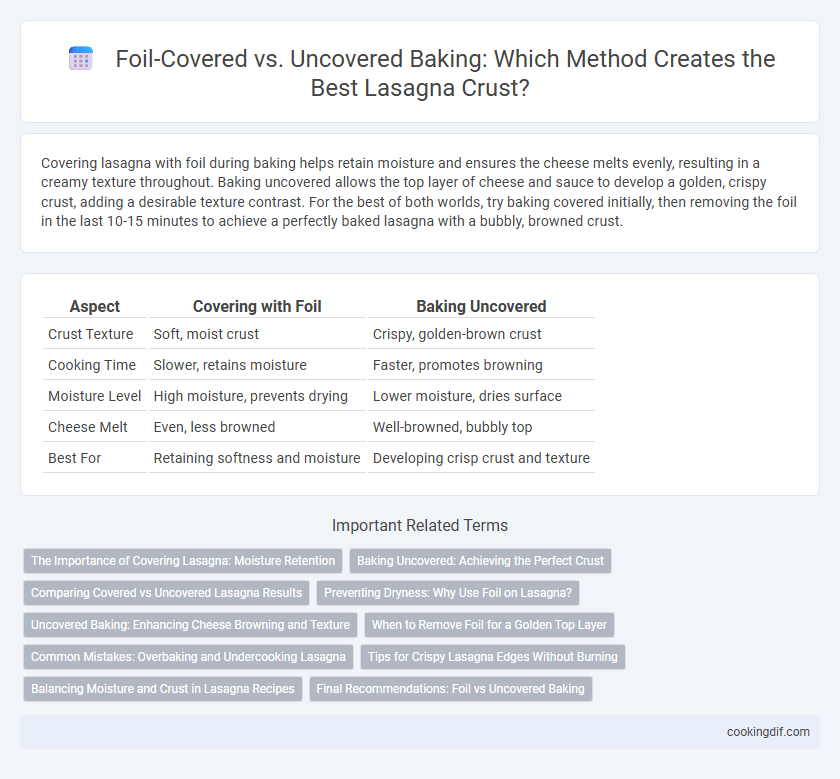Covering lasagna with foil during baking helps retain moisture and ensures the cheese melts evenly, resulting in a creamy texture throughout. Baking uncovered allows the top layer of cheese and sauce to develop a golden, crispy crust, adding a desirable texture contrast. For the best of both worlds, try baking covered initially, then removing the foil in the last 10-15 minutes to achieve a perfectly baked lasagna with a bubbly, browned crust.
Table of Comparison
| Aspect | Covering with Foil | Baking Uncovered |
|---|---|---|
| Crust Texture | Soft, moist crust | Crispy, golden-brown crust |
| Cooking Time | Slower, retains moisture | Faster, promotes browning |
| Moisture Level | High moisture, prevents drying | Lower moisture, dries surface |
| Cheese Melt | Even, less browned | Well-browned, bubbly top |
| Best For | Retaining softness and moisture | Developing crisp crust and texture |
The Importance of Covering Lasagna: Moisture Retention
Covering lasagna with foil during baking is crucial for moisture retention, preventing the pasta layers from drying out and ensuring a tender, evenly cooked dish. Foil traps steam inside the pan, maintaining the sauce's moisture and enhancing the lasagna's overall texture and flavor. Baking uncovered can create a crispier crust but risks drying out the interior, compromising the lasagna's moist and hearty consistency.
Baking Uncovered: Achieving the Perfect Crust
Baking lasagna uncovered allows the top layer of cheese and sauce to caramelize, creating a rich, golden-brown crust that enhances flavor and texture. This method promotes moisture evaporation, concentrating the dish's savory components while adding a slight crispiness to the edges. Achieving the perfect crust requires careful oven temperature control, typically around 375degF, for 30 to 45 minutes, ensuring even browning without drying out the interior layers.
Comparing Covered vs Uncovered Lasagna Results
Baking lasagna covered with foil retains moisture, resulting in a tender, evenly cooked interior but a softer top layer without a browned crust. Uncovered baking promotes caramelization and a golden, crispy cheese crust by allowing moisture to escape, enhancing texture and flavor complexity. Optimal lasagna texture balances initial covered baking to cook through, followed by uncovered baking to develop a desirable, browned crust.
Preventing Dryness: Why Use Foil on Lasagna?
Covering lasagna with foil during baking helps retain moisture by trapping steam, preventing the pasta and cheese layers from drying out. Baking uncovered promotes a crispier crust but risks drying the top layer and melting cheese unevenly. Using foil strikes a balance, ensuring the lasagna remains juicy and tender while allowing final browning when uncovered in the last minutes of baking.
Uncovered Baking: Enhancing Cheese Browning and Texture
Baking lasagna uncovered allows the cheese topping to brown evenly, creating a golden, crispy crust that enhances both flavor and texture. Exposure to direct heat promotes Maillard reactions in the cheese, resulting in a rich, savory crust that foil-covered lasagna often lacks. This method also helps excess moisture evaporate, preventing a soggy top and ensuring a satisfying, textured finish.
When to Remove Foil for a Golden Top Layer
Covering lasagna with foil during baking traps moisture, preventing the top layer from drying out and burning, while baking uncovered promotes a golden, crispy crust. Remove the foil during the last 10 to 15 minutes of baking to allow the cheese and edges to brown evenly without overcooking the interior. This timing ensures a perfectly baked lasagna with a bubbly, golden top and tender layers within.
Common Mistakes: Overbaking and Undercooking Lasagna
Covering lasagna with foil traps moisture, preventing the top from developing a crispy crust but helps avoid overbaking and drying out the layers. Baking uncovered promotes a golden, bubbly crust but risks undercooking the inner layers if not monitored carefully. A common mistake is removing the foil too early or too late, leading to either a soggy top or a dry, overcooked casserole.
Tips for Crispy Lasagna Edges Without Burning
Covering lasagna with foil traps steam, which keeps the edges moist but can prevent a crispy crust from forming. Baking uncovered allows the edges to dry out and crisp up, but it requires careful monitoring to avoid burning. A balanced tip is to bake lasagna covered for most of the time, then uncover it during the last 10-15 minutes to achieve perfectly crispy, golden edges without overcooking.
Balancing Moisture and Crust in Lasagna Recipes
Covering lasagna with foil during baking helps retain moisture, preventing the pasta and cheese from drying out while ensuring even heat distribution. Baking uncovered in the final 10-15 minutes promotes a golden, bubbly crust as the top layer of cheese caramelizes and crisps. Balancing these techniques maintains a moist interior with a desirable, textured crust, enhancing the overall lasagna experience.
Final Recommendations: Foil vs Uncovered Baking
Covering lasagna with foil during baking traps steam, resulting in a moist, evenly cooked dish, while baking uncovered promotes a golden, crispy crust on top. For a balance between a tender interior and a browned, bubbly cheese topping, start baking covered and uncover during the last 10-15 minutes. Final recommendations favor a hybrid approach: use foil initially to prevent drying, then remove it to achieve a desirable crisp, textured crust.
Covering with foil vs Baking uncovered for crust Infographic

 cookingdif.com
cookingdif.com